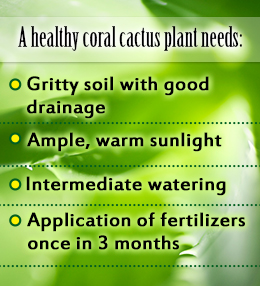The coral cactus plant is a beautiful, potted plant variety, which can display a lot of versatility in beautifying outdoor landscapes as well as indoor areas. Its coral reef like appearance is where its name originates from. Let us now look at the best way to grow and care for a coral cactus plant.

Quick Fact
A coral cactus plant (euphorbia lactea crest) is not a real cactus. It is actually a euphorbia plant that has a rare mutation, which causes it to grow with a crest-like appearance. Because this interesting mutation is very rare, the plant is a very sought-after item.This weird-looking plant closely resembles an ocean coral. It is extremely hardy and requires almost no care to survive. Its green and pinkish color makes it a popular choice in many gardens, even though it can also be used to increase the appeal of the ambiance indoors. It is a small plant that does not grow more than 25 inches in height.
The plant is a result of grafting the crest-shaped top of a Euphorbia Lactea on the stock and root of a Euphorbia neriifolia, or on the root of a cactus. The plants have their origins from the nurseries of a few experimental horticulturists. Although the grafting process is a little complex, taking care of a successfully grafted plant is a piece of cake in comparison. We shall first look at how the plant is grown and propagated followed by tips on coral cactus care, to help it thrive.
Growth and Propagation of Coral Cactus
To successfully graft a coral cactus, the following procedure has to be followed:
- A v-shaped cut has to be made at the base of the Euphorbia lactea plant's crest. The cut should curve outward.
- Now the root stock of the cactus or Euphorbia neriifolia has to also be cut in a v-shape. However, the cut must curve inwards.
- Now place the two sections together in such a way that the joint comes together well.
- Cover the joint with grafting wax, to prevent the plant from drying, and tie the plant with rope or twine to hold the two pieces of the plant together till it heals.
- If the two plants are compatible, the graft should completely heal in a few weeks. If you find that the plant has not healed fully, replace the wax and rope. However, be careful during this time, as a little damage can set back the healing process considerably.
- Babies of the coral cactus will eventually grow from the same plant. Cut off these new growths, and dry them for a couple of weeks and pot them. The plants will soon get roots. After this happens, plant the saplings in the soil; however, these new saplings may or may not form crests, and there is no way to force the way these plants will grow. If your new euphorbia does form crests, you may have to repeat the above process all over again.
With proper care, your coral cactus can bloom with beautiful purple or pink flowers. This usually takes place around a year after the grafting, and occurs yearly, in warm conditions.
Coral Cactus Care Tips
- Plant the coral cactus plant in a gritty soil which drains easily. You can do this by mixing regular potting soil with an equal amount of sand.
- Do not bury the plant more than root deep. It helps protect the euphorbia from rot.
- The plant can thrive in an arid environment. To artificially stimulate this, place the plant in a place with warm, bright, but indirect sunlight. The ideal temperature around the plant should be 60-70 degrees Fahrenheit.
- Water the plants intermediately, to keep the soil slightly moist. Excess water causes the plant to start dying. The root and the flesh of the plant start to rot. To avoid this, let the soil completely dry from the previous watering before you pour some again. Burying your finger deep in the soil will give you an idea, about whether you should water it or not.
- Use diluted solutions of fertilizers once during spring followed by once in the fall.
- Regularly turn the plant side which is facing the sun. This prevents the plant from growing lopsided.
- Re-potting the plant is needed as soon as you bring the plant home, because the store-bought container is usually ceramic, which is not suitable for the plant's growth.
- The hardiness zone of this plant is 10-11, so grow the plant accordingly.
The coral cactus plant produces toxic latex sap, hence it should be kept out of the reach of children and pets. One must always use gloves while handling the plant and should wash them after, just to be safe. However, this is a great low-maintenance plant that is sure to increase the appeal of the area it is kept in, be it your home, office, or garden, so what are you waiting for? Go ahead, and get one for yourself.






